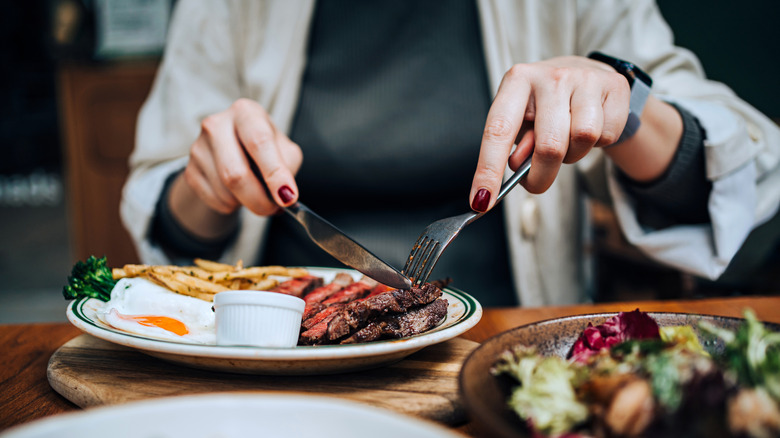The Chains Have Slightly Different Vibes
Both Texas Roadhouse and LongHorn Steakhouse lean into a rustic, country-style aesthetic. Diners can expect dining booths, plenty of wooden accents, and walls adorned with bric-a-brac. However, despite these similarities, the overall atmosphere at each chain is distinct.
Texas Roadhouse offers first-time diners and regulars a more laid-back and rowdier vibe, with many locations known for servers who break into regular line dances. In addition to neon signs and murals, each Texas Roadhouse restaurant also features a special corner that commemorates the country music icon Willie Nelson. Affectionately known as “Willie’s Corner,” the area displays photos, records, and other keepsakes that pay tribute to the singer’s rich legacy — and his friendship with the restaurant’s founder Kent Taylor.
While LongHorn Steakhouse has a casual vibe, it’s more polished than Texas Roadhouse. The chain, which takes its name from a North American breed of cattle with impressively long horns, embraces sleek, Southern decorative elements. These include wall-mounted horse saddles, paintings of the serene countryside, low-hanging chandeliers made from deer antlers, and taxidermied animals. The lighting is subdued, making the restaurant perfect for cozy nights out, ranging from laid-back celebrations to date nights.
LongHorn Steakhouse Sticks To Classic Steaks While Texas Roadhouse Is More Experimental
There is a good reason why some steak cuts have withstood the test of time as steakhouse menu staples. Well-known for their tenderness, marbling, and bold flavors, these classics have remained favorites among both chefs and diners. Bearing this in mind, it’s not surprising that LongHorn Steakhouse has chosen to focus its menu on these cuts of beef. The chain’s “Legendary Steaks” include sirloin, ribeye, filet mignon, New York strip, T-bone, and porterhouse. The restaurant’s only beefy alternative to a classic steak is the chop steak, a dish made with ground beef, roasted mushrooms, caramelized onions, and savory garlic herb sauce.
While Texas Roadhouse also offers traditional cuts, the chain is more creative with its beef dishes than LongHorn Steakhouse. On the classic side, the restaurant’s menu features sirloin, New York strip, filet mignon, ribeye, bone-in ribeye, and porterhouse T-bone. Aside from these iconic cuts, Texas Roadhouse also serves other beef dishes, including slow-roasted prime rib (which is always better in restaurants), country fried sirloin, tender beef tips, and steak kabob with onions, mushrooms, tomatoes, red peppers, and green peppers. Finally, there is the chain’s cheekily named Road Kill, a chop steak topped with sautéed onions, sautéed mushrooms, and jack cheese.
LongHorn Steakhouse Is Less Transparent About The Grade Of Its Beef
The USDA classifies beef into three different categories. The top designation is USDA Prime, which only makes up around 2% of all the beef graded by the organization and is typically served at upscale steakhouses. USDA Prime beef has the most marbling, making it both the juiciest and most tender. Next, USDA Choice refers to cuts with a decent amount of marbling. Finally, USDA Select is the leanest of the three, making it less tender and juicy than the other two grades.
Texas Roadhouse serves USDA Choice beef (never frozen), and the company is upfront about it. This means that its steaks are flavorful and tender without the high prices of USDA Prime cuts. The chain also specifies that its beef suppliers adhere to the animal handling practices outlined by the North American Meat Institute and National Cattlemen’s Beef Association’s Beef Quality Assurance.
LongHorn Steakhouse isn’t as upfront about the quality of its beef. According to the LongHorn Steakhouse website, the chain uses “quality cuts” that are “always fresh, never frozen, and custom-trimmed.” Still, the restaurant doesn’t specify whether its beef is USDA graded and, if so, what designation it falls under.
The Restaurants Season And Grill Their Steaks In Distinct Ways
Every Texas Roadhouse location employs an in-house butcher tasked with cutting every steak by hand. The meat cutters work in 34-degrees Fahrenheit coolers, cutting approximately a million dollars-worth of meat each year at every restaurant. As for why Texas Roadhouse steaks taste so good, the chain hasn’t disclosed the recipe for its seasoning — but a Redditor who claims to be a former employee has described its steak preparation process, saying: “[The] seasoning came premixed for us. The way we were taught is to ‘coast to coast’ each side, sear on a 400 degree flattop for a minute on each side with about a teaspoon of butter. […] After that, straight to a clean oiled grill and cook until perfection. You can go straight to the grill but I prefer searing as it helps bring the steak up from ice cold to more room temperature and [promotes] more even cooking.”
LongHorn Steakhouse is slightly more transparent about its steak seasoning recipes by highlighting three different options on its website — Grill Seasoning, Char Seasoning, and Prairie Dust Seasoning. Unfortunately, the restaurant doesn’t provide any details regarding the specific herbs and spices in each seasoning mix. LongHorn sells a proprietary steak seasoning, which may provide a clue about the ingredients used in the restaurant seasoning. According to the product packaging, the seasoning is made with salt, spices, garlic powder, onion powder, paprika, and additives.
LongHorn Steakhouse prepares its steak cuts on an open-fire grill.
Texas Roadhouse Allows Diners To Choose Their Cuts Of Beef From A Display Case
Not only does Texas Roadhouse have a designated meat cutter at each location, it also allows carnivores to pick out specific cuts of beef. Like selecting fresh fish and seafood from a tank at high-end restaurants, Texas Roadhouse lets diners inspect the cuts of beef available on a particular day. One Redditor swears by selecting their steak from the restaurant’s display case, saying, “Pro tip for anyone reading: Always choose your steak from the case up front. They put their best (most marbled) steaks in the case.” Of course, diners who prefer a simpler approach to steak selection can still choose their dish from the chain’s regular menu.
To select your own steak at Texas Roadhouse, simply tell the server that you would like to take a look at the restaurant’s display case. Feel free to ask the butcher any questions about each cut’s marbling, thickness, and the recommended doneness level. Once selected, the steak is tagged with one part of a ticket while the diner holds onto the other. This ensures that the selected cut is prepared to the diner’s desired specifications and arrives at the correct table.
Texas Roadhouse May Be Slightly Easier To Find
With hundreds of restaurants, both Texas Roadhouse and LongHorn Steakhouse have a substantial presence across the U.S. However, when it comes to exact numbers and geographic coverage, Texas Roadhouse has the upper hand over LongHorn Steakhouse — but only by a slim margin.
Texas Roadhouse has nearly 700 restaurants in 52 U.S. states and territories, with a large number located in Texas. While this regional concentration reflects the restaurant’s name, it doesn’t match its roots — Texas Roadhouse’s first restaurant opened at the Green Tree Mall in Clarksville, Indiana. The other two states with a considerable Texas Roadhouse presence are Florida and Ohio.
LongHorn Steakhouse operates close to 600 restaurants in 43 states and more than 500 cities. The chain has the greatest foothold in Florida, with eight restaurants in Orlando and six outlets in Jacksonville. LongHorn also maintains a strong presence in Georgia and Texas.
LongHorn Steakhouse Is More Expensive Than Texas Roadhouse
There are steakhouses and then there are steakhouses. While all serve beef, some can leave you substantially more out of pocket than others. Luckily, neither LongHorn Steakhouse nor Texas Roadhouse fall into the latter category. However, this doesn’t mean that their prices are identical.
In line with its slightly more upscale ambiance, LongHorn Steakhouse charges a little more for its dishes than Texas Roadhouse. For instance, a 12-ounce New York strip at Texas Roadhouse will set you back around $23 while the same dish costs approximately $26 at LongHorn Steakhouse. The most expensive steak on Texas Roadhouse’s menu is the 23-ounce porterhouse T-bone at $34, whereas LongHorn Steakhouse charges over $35 for a slightly smaller 22-ounce porterhouse.
Other menu items also reflect the slight price disparity between the chains. For instance, Texas Roadhouse’s boneless Buffalo wings are $12.99, while LongHorn prices its seasoned wings at $14.99. In terms of entrées, the salmon at Texas Roadhouse is between $18.99 and $22.99, whereas a comparable dish at LongHorn costs around $25. Meanwhile, the side dishes at Texas Roadhouse are all $3.99, while at LongHorn Steakhouse, accompaniments start at $3.99 and go up to $6.49, depending on the selection.
The Sides Could Sway Your Decision
Whether creamy, starchy, or crispy, side dishes make a nice contrast to the savory flavor profile and richness of a well-prepared steak. They also round out the meal, balancing out its textures and nutritional profile.
LongHorn Steakhouse and Texas Roadhouse serve their steaks with a choice of two sides. And while both chains offer a comparable number of side dishes, the offerings at LongHorn are a little more gourmet. For example, the corn at LongHorn is fire grilled and finished with crema and seasoned Parmesan cheese, whereas Texas Roadhouse offers buttered corn. Similarly, LongHorn Steakhouse offers mac and cheese made with four cheeses, smoked bacon, and Parmesan bread crumbs, while Texas Roadhouse sticks to a more basic version of the accompaniment.
Aside from a few exceptions, the chains offer the typical steakhouse side dishes. In terms of starch, both the restaurants serve loaded baked potatoes, sweet potatoes, mashed potatoes, and French fries. In the veggie department, LongHorn Steakhouse serves steamed broccoli, steamed asparagus, crispy Brussels sprouts, and a range of salads. Meanwhile, Texas Roadhouse offers steamed broccoli, steamed vegetables, green beans, sautéed onions, and a choice of two salads.
Both Chains Offer Children’s Menus
As a rule of thumb, the more upscale the steakhouse, the less family-friendly it can be, and the less likely to have a children’s menu. However, while LongHorn Steakhouse may be more formal than Texas Roadhouse, it still welcomes families and offers a dedicated menu for kids.
Available for children under 12 years of age, the children’s menu at LongHorn Steakhouse features a handful of different items. These include a cheeseburger, fried chicken tenders with a honey mustard sauce, grilled chicken tenders, and macaroni and cheese. There is also a kid-friendly 6-ounce grilled sirloin. All children’s meals at LongHorn Steakhouse are served with one choice from the side dish menu.
While Texas Roadhouse doesn’t specify the age limit for its “Kids and Ranger Meals,” a recent article in The U.S. Sun suggests that the cutoff age is normally 12. According to the article, some Texas Roadhouse locations don’t necessarily follow this rule, also allowing adults to order from the kids’ menu. The chain’s selection of meals for children is a little larger than that at LongHorn. In terms of fast-food-style items, the restaurant offers mini-cheeseburgers, chicken tenders, and beef hot dogs. Young diners in the mood for something more steakhouse-y can order a sirloin steak, steak bites, or a rib basket.
The Birthday Perks At Texas Roadhouse Are Better
Hosting birthdays at home can be stressful. From planning the menu to cleaning up after everybody has gone home, home birthdays can feel like a chore rather than a celebration. Dining out can take the pressure off, allowing everybody to enjoy the festivities without any pressure. Even better, if the restaurant throws in a birthday perk or two.
When it comes to birthdays, Texas Roadhouse delivers. The highlight of the experience is the restaurant’s signature birthday saddle ride, where the celebrant straddles a mounted saddle while the staff serenade them with cheers and maybe even a song. Depending on the location, Texas Roadhouse also adds to the celebrations with a free appetizer, side of ribs, or dessert. To be eligible for the complimentary offerings, guests have to join the Texas Roadhouse VIP Club through the restaurant’s website or app.
While LongHorn Steakhouse gives out birthday offers and coupons for guests who sign up for its eClub, the experience is more understated. Instead of being placed in the spotlight, birthday diners may receive a small gesture, such as a complimentary birthday dessert.
Both Chains Serve A Variety Of Margaritas
Margaritas are a crowd-pleaser. The combination of tequila, Cointreau, and lemon juice, served in a glass with a salted rim is a firm favorite at a range of establishments, from Mexican restaurants to steakhouses. Given their wide appeal, it’s not surprising that both LongHorn Steakhouse and Texas Roadhouse offer a variety of Margaritas on their drink menus.
On the classic end of the spectrum, Texas Roadhouse offers the House Rocks Margarita and the House Frozen Margarita with Dorado Gold Tequila. For something a little harder, guests can opt for The Legend Margarita with Patrón Silver, Patrón Reposado, and Patrón Añejo. Meanwhile, LongHorn’s traditional takes on Margarita include the house Margarita with gold tequila and triple sec, and The Perfect with blue agave el Jimador Tequila.
Both Texas Roadhouse and LongHorn Steakhouse also serve more creative Margaritas. For Texas Roadhouse, these include the Fruity Margarita with strawberries or raspberries, Mango Margarita with mango purée, and Hurricane Margarita with grenadine, orange, and pineapple juice. The chain also offers a little Spanish flair on its menu with Sangria Margarita. LongHorn Steakhouse also features strawberry and mango Margaritas — both with el Jimador Tequila. For something a little more out-of-the-box, the chain serves Patrón Dragon Fruit Margarita, made with Patrón Reposado Tequila, triple sec, dragon fruit, and pineapple.
So Which Steakhouse Comes Out On Top?
After reviewing the offerings at both chains, we believe that Texas Roadhouse offers an overall better experience and value for money. While it may not be quite as polished as LongHorn Steakhouse, the chain is more transparent about its beef sourcing practices. It also allows diners to choose specific cuts of steak from a display cabinet, lowering the risk of unpleasant surprises.
Aside from being more budget-friendly, Texas Roadhouse also offers a casual atmosphere that may be more suited to family and group dining. The line dancing and special birthday celebrations only add to this appeal. That said, diners looking for a more subdued and refined dining experience may still prefer LongHorn’s slightly more upscale dishes and atmosphere.
Methodology
Comparing two restaurants with so many similarities isn’t always easy. However, as they say, it’s the little things that make the difference. Never ones to shy away from a challenge, we decided to tackle this task head on. To evaluate how LongHorn Steakhouse and Texas Roadhouse stack up against each other, we considered several factors. First, we examined each chain’s ambiance. Next, we evaluated their range of steaks and beef quality. Finally, we considered the finer details, such as side dishes, special promos, cocktails, and prices.
For more food and drink goodness, join The Takeout’s newsletter. Get taste tests, food & drink news, deals from your favorite chains, recipes, cooking tips, and more!







